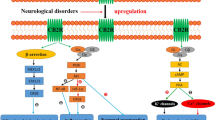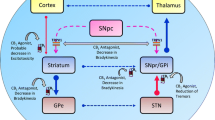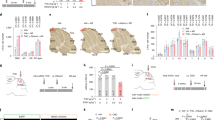Abstract
Cerebellar ataxia is a neurodegenerative disorder leading to severe motor incoordination. Recently, it has been suggested that cannabinoids play a role in modulating ataxic symptoms. To understand the possible therapeutic effect of cannabinoids for the management of cerebellar ataxia, we used cannabinoid agonist/antagonists to target the cannabinoid type 1 receptor (CB1R) in the 3 acetyl pyridine (3AP) rat model of ataxia. The role of the CB1R was examined using three different doses of the CB1R agonist, WIN-55,212–2 (WIN; 0.1, 0.5, 1 mg/kg) administrated 30 min prior to 3AP (55 mg/kg, i.p.) which leads to motor impairment through destruction of the inferior olive. In some groups, the CB1R antagonist AM251 (1 mg/kg) was given in combination with WIN. Locomotor activity and motor coordination were impaired by 3AP, and the application of WIN did not ameliorate this effect. However, the abnormal gait, rearing and grooming caused by 3AP were prevented by co-administration of AM251 with WIN. While the addition of the CB1R antagonist improved some ataxic symptoms, there was no effect of AM251 on balance or locomotor activity when co-administrated with WIN. Behavioral testing indicated that not only did WIN fail to exert any protective effect on ataxic symptoms; it exacerbated ataxic symptoms, suggesting that CB1R agonists may not be the ideal therapeutic drug in this disorder. When taken together, the findings from the present study indicate that cannabinoid modulation of ataxia symptoms may not act solely through CB1Rs and other cannabinoid receptors should be considered in future studies.






Similar content being viewed by others

Data availability
The datasets used or analyzed during the current study are available from the corresponding author on reasonable request.
Code availability
All software applications used are included in this article.
References
Abbasloo A, Wiens V, Hermann M, Schultz T (2015) Visualizing tensor normal distributions at multiple levels of detail. IEEE Trans vis Comput Graph 22(1):975–984
Abbassian H, Esmaeili P, Tahamtan M, Aghaei I, Vaziri Z, Sheibani V, Whalley BJ, Shabani M (2016a) Cannabinoid receptor agonism suppresses tremor, cognition disturbances and anxiety-like behaviors in a rat model of essential tremor. Physiol Behav 164(Pt A):314–320
Abbassian H, Whalley BJ, Sheibani V, Shabani M (2016b) Cannabinoid type 1 receptor antagonism ameliorates harmaline-induced essential tremor in rat. Br J Pharmacol 173(22):3196–3207
Barenberg P, Strahlendorf H, Strahlendorf J (2001) Hypoxia induces an excitotoxic-type of dark cell degeneration in cerebellar Purkinje neurons. Neurosci Res 40(3):245–254
Bastian AJ (2006) Learning to predict the future: the cerebellum adapts feedforward movement control. Curr Opin Neurobiol 16(6):645–649
Baul HS, Manikandan C, Sen D (2019) Cannabinoid receptor as a potential therapeutic target for Parkinson’s disease. Brain Res Bull 146:244–252
Berridge KC (1990) Comparative fine structure of action: rules of form and sequence in the grooming patterns of six rodent species. Behaviour 113(1–2):21–56
Clifford DB (1983) Tetrahydrocannabinol for tremor in multiple sclerosis. Ann Neurol 13(6):669–671
Colin F, Manil J, Desclin J (1980) The olivocerebellar system. I. Delayed and slow inhibitory effects: an overlooked salient feature of cerebellar climbing fibers. Brain Res 187(1):3–27
Consroe P, Musty R, Rein J, Tillery W, Pertwee R (1997) The perceived effects of smoked cannabis on patients with multiple sclerosis. Eur Neurol 38(1):44–48
DeSanty KP, Dar MS (2001) Cannabinoid-induced motor incoordination through the cerebellar CB(1) receptor in mice. Pharmacol Biochem Behav 69(1–2):251–259
Didonna A, Sussman J, Benetti F, Legname G (2012) The role of Bax and caspase-3 in doppel-induced apoptosis of cerebellar granule cells. Prion 6(3):309–316
Dugger BN, Dickson DW (2017) Pathology of neurodegenerative diseases. Cold Spring Harb Perspect Biol 9(7):a028035
Fernández-Ruiz J, Moro MA, Martínez-Orgado J (2015) Cannabinoids in neurodegenerative disorders and stroke/brain trauma: from preclinical models to clinical applications. Neurotherapeutics 12(4):793–806
Festjens N, Vanden Berghe T, Vandenabeele P (2006) Necrosis, a well-orchestrated form of cell demise: signalling cascades, important mediators and concomitant immune response. Biochim Biophys Acta 1757(9–10):1371–1387
Garcia I, Crowther AJ, Gama V, Miller CR, Deshmukh M, Gershon TR (2013) Bax deficiency prolongs cerebellar neurogenesis, accelerates medulloblastoma formation and paradoxically increases both malignancy and differentiation. Oncogene 32(18):2304–2314
Garman RH (2011) Histology of the central nervous system. Toxicol Pathol 39(1):22–35
Glynn D, Drew CJ, Reim K, Brose N, Morton AJ (2005) Profound ataxia in complexin I knockout mice masks a complex phenotype that includes exploratory and habituation deficits. Hum Mol Genet 14(16):2369–2385
Gómez-Ruiz M, Rodríguez-Cueto C, Luna-Piñel E, Hernández-Gálvez M, Fernández-Ruiz J (2019) Endocannabinoid system in spinocerebellar ataxia type-3 and other autosomal-dominant cerebellar ataxias: potential role in pathogenesis and expected relevance as neuroprotective targets. Front Mol Neurosci 12:94
Khalid N, Azimpouran M (2022) Necrosis StatPearls Treasure Island (FL), StatPearls Publishing Copyright © 2022. StatPearls Publishing LLC, New York
Leija-Salazar M, de León MB, González-Horta A, González-Hernández B (2020) Arachidonyl-2′-chloroethylamide (ACEA), a synthetic agonist of cannabinoid receptor, increases CB1R gene expression and reduces dyskinesias in a rat model of Parkinson’s disease. Pharmacol Biochem Behav 194:172950
Navarro G, Morales P, Rodríguez-Cueto C, Fernández-Ruiz J, Jagerovic N, Franco R (2016) Targeting cannabinoid CB2 receptors in the central nervous system. Medicinal chemistry approaches with focus on neurodegenerative disorders. Front Neurosci 10:406
Patel S, Hillard CJ (2001) Cannabinoid CB(1) receptor agonists produce cerebellar dysfunction in mice. J Pharmacol Exp Ther 297(2):629–637
Rauf S, Soesatyo MH, Agustiningsih D, Partadiredja G (2020) Moderate intensity intermittent exercise upregulates neurotrophic and neuroprotective genes expression and inhibits Purkinje cell loss in the cerebellum of ovariectomized rats. Behav Brain Res 382:112481
Rodriguez-Cueto C, Hernandez-Galvez M, Hillard CJ, Maciel P, Garcia-Garcia L, Valdeolivas S, Pozo MA, Ramos JA, Gomez-Ruiz M, Fernandez-Ruiz J (2016) Dysregulation of the endocannabinoid signaling system in the cerebellum and brainstem in a transgenic mouse model of spinocerebellar ataxia type-3. Neuroscience 339:191–209
Shabani M, Hosseinmardi N, Haghani M, Shaibani V, Janahmadi M (2011) Maternal exposure to the CB1 cannabinoid agonist WIN 55212–2 produces robust changes in motor function and intrinsic electrophysiological properties of cerebellar Purkinje neurons in rat offspring. Neuroscience 172:139–152
Shabani M, Larizadeh MH, Parsania S, Asadi Shekaari M, Shahrokhi N (2012a) Profound destructive effects of adolescent exposure to vincristine accompanied with some sex differences in motor and memory performance. Can J Physiol Pharmacol 90(4):379–386
Shabani M, Larizadeh MH, Parsania S, Hajali V, Shojaei A (2012b) Evaluation of destructive effects of exposure to cisplatin during developmental stage: no profound evidence for sex differences in impaired motor and memory performance. Int J Neurosci 122(8):439–448
Smeets CJ, Verbeek D (2016) Climbing fibers in spinocerebellar ataxia: a mechanism for the loss of motor control. Neurobiol Dis 88:96–106
Stephens G (2016) Does modulation of the endocannabinoid system have potential therapeutic utility in cerebellar ataxia? J Physiol 594(16):4631–4641
Wang X, Whalley BJ, Stephens GJ (2013) The du2J mouse model of ataxia and absence epilepsy has deficient cannabinoid CB1 receptor-mediated signalling. J Physiol 591(16):3919–3933
Zhao L, Spassieva SD, Jucius TJ, Shultz LD, Shick HE, Macklin WB, Hannun YA, Obeid LM, Ackerman SL (2011) A deficiency of ceramide biosynthesis causes cerebellar purkinje cell neurodegeneration and lipofuscin accumulation. PLoS Genet 7(5):e1002063
Zou S, Kumar U (2018) Cannabinoid receptors and the endocannabinoid system: signaling and function in the central nervous system. Int J Mol Sci 19(3):833
Acknowledgements
The authors thank Dr. Moazamehosadat Razavinasab for helping in the illustration provided in this article.
Author information
Authors and Affiliations
Contributions
HR and MS have conceived and designed the concept and road map of the study, searched the literature, designed the concept map and figures, and drafted the manuscript. MJ, KAK, and VS have critically reviewed the manuscript for its content, originality, usage of English language, and accuracy of interpreted data. MA carried out the immunohistochemistry experiment and preformed statistical analysis. MSH designed the study, helped in manuscript preparation, and critically reviewed the manuscript. MSH is the archival author and attests to the integrity of the original data and the analysis reported in this manuscript. All authors have made substantive contribution and attest to approving the final manuscript. The authors declare that all data were generated in-house and that no paper mill was used.
Corresponding author
Ethics declarations
Conflict of interest
The authors declare no conflict of interest and declare that the research was conducted in the absence of any commercial or financial relationships that could be construed as a potential conflict of interest.
Ethical approval
All procedures performed in studies were in accordance with the ethical standards of the ethical committee of Kerman University of Medical Sciences (Ethical approval number: IR.KMU.REC.1398.012, Reg. No. 97000860).
Consent to participate
The protocol was established, according to the ethical guidelines of the Helsinki Declaration, and was approved by the Institutional Ethics Committee of Kerman University of Medical Sciences.
Consent for publication
Not applicable.
Additional information
Communicated by Sreedharan Sajikumar.
Publisher's Note
Springer Nature remains neutral with regard to jurisdictional claims in published maps and institutional affiliations.
Rights and permissions
About this article
Cite this article
Ranjbar, H., Soti, M., Janahmadi, M. et al. Modulation of the CB1 cannabinoid receptor has potential therapeutic utility in the 3-acetylpyridine cerebellar ataxia rat model. Exp Brain Res 240, 2339–2348 (2022). https://doi.org/10.1007/s00221-022-06415-6
Received:
Accepted:
Published:
Issue Date:
DOI: https://doi.org/10.1007/s00221-022-06415-6



